The retreat that I joined was hosted by Ven. Master Guo-yuan (果元法師), I reported my arrival on 5th April at around 1pm in the Meditation Hall of DDM and left the mountain on 13th morning at around 8:30am. The entire retreat was memorable, not only the technique taught is awesome, but also the sincere attitude the dharma workers (i.e. volunteers) and the Zen atmosphere of DDM. One of the very good things about DDM retreat is that they look at very tiny details that may affect the mind of practitioners, from eating manners to toilet facilities were all meticulously tailored for retreat practice. When I arrived DDM, I felt calm and tranquil, the monastery had a very strong sense of Japanese Zen, designs are simple and plain, this is probably because VM Sheng-yen studied in Japan before, for those who would like to join Zen retreats, I highly recommend DDM. The retreat there not only followed traditional Chinese Zen retreat, but incorporated elements of Theravada and Japanese Zen, such as slow walking meditation and ‘just sitting’, it runs more like a course and has Q&A sessions, making it distinct from retreats elsewhere.
Before I start depicting my trip in details, let me spell a few words regarding transports to DDM, especially for those backpackers who might be interested for a short visit or having a retreat there. For me, initially I took a flight to Taoyuan International Airport, Taipei, and took a shuttle to Taipei Train Station (cost about TWD145), upon arrival at the Train Station, I walked for about 10 minutes until I found Guodao Coach Station*, where there was a direct shuttle bus to DDM (cost about TWD100). For those who would like to join a retreat at DDM, please note that they may arrange shuttle bus to pick you up at Taipei Train Station, which would cost about TWD300, however.
(*please note that this is just a literal translation of the station, in Chinese it is “國道客運站”.)
Below are some photos taken by myself and online sources, a glimpse of the surroundings in DDM.
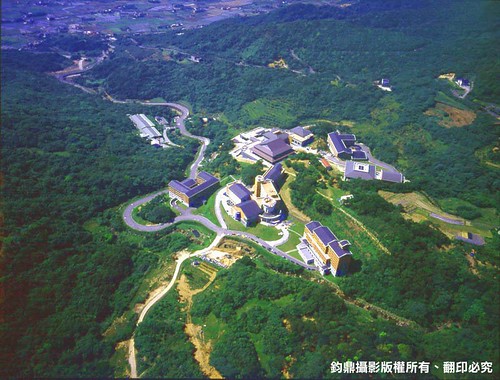
An Aerial View of DDM

The mountain gate of DDM

A Welcoming Guanyin Statue

Architectural Complex of DDM
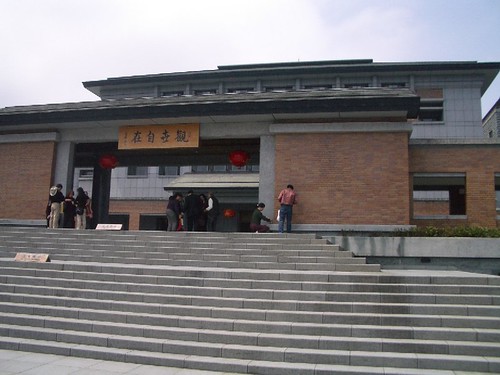
Guanyin Hall I
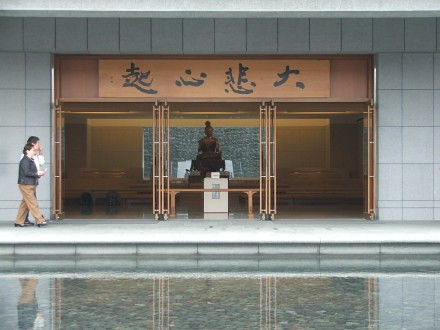
Guanyin Hall II
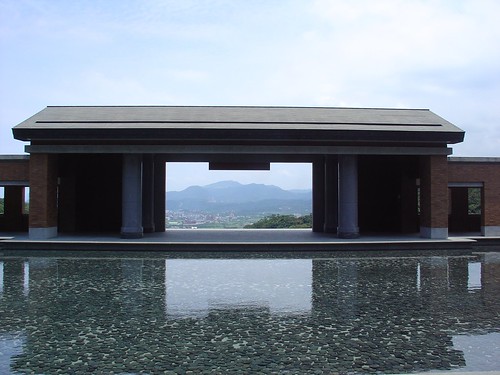
A pool in front of Guanyin Hall, which is static, pure and clear, I felt totally tranquil and calm, if you look down from the gate there, you could see the entire Jinshan town.
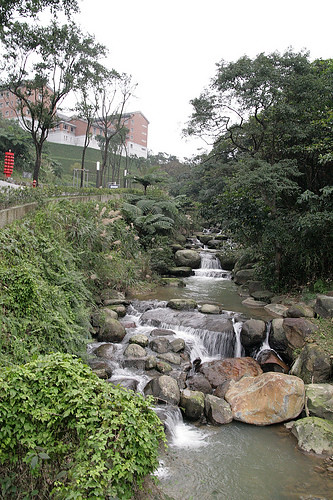
Stream I

Stream II: there are two streams in DDM, one pure, one sandy, I guess its philosophy is that Zen embraces both clean and unclean.

The Grand Hall
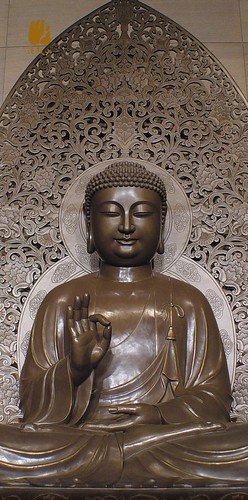
Buddha Statue inside the Grand Hall
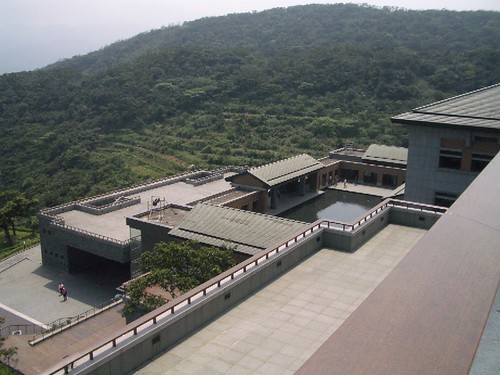
Taken from the outskirt of the Grand Hall, below is Guanyin Hall and vegetarian canteen (which provide free food to the public.)
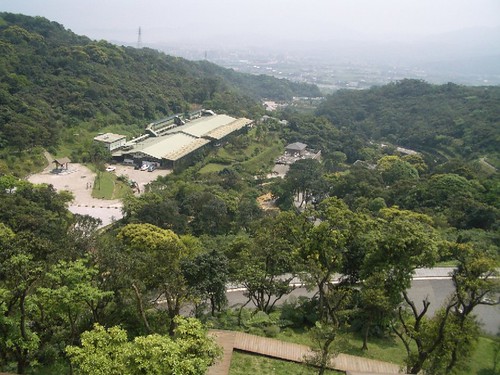
The left side of this picture is the dormitory for dharma workers.
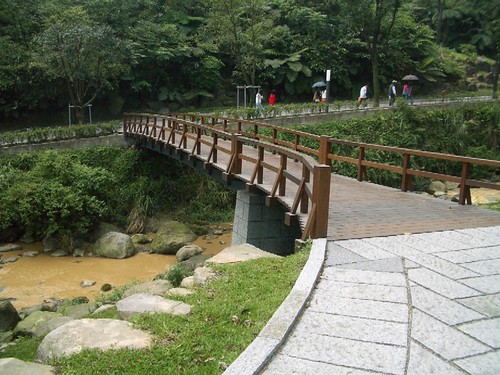
The bridge to Lotus Bell Pavilion

Lotus Bell Pavilion
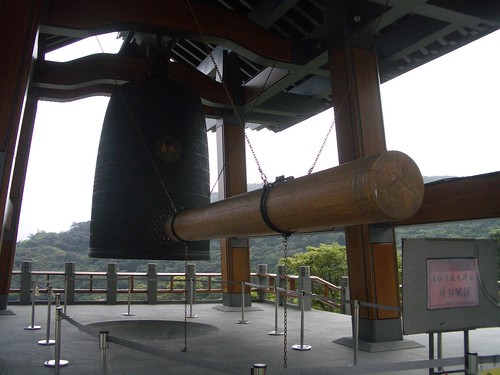
Lotus Bell I (inscribed with the entire Lotus Sutra and Great Compassion Mantra, which has about 70,000 characters), the bell would be stricken 108 times ONLY on Lunar New Year’s Eve

Lotus Bell II
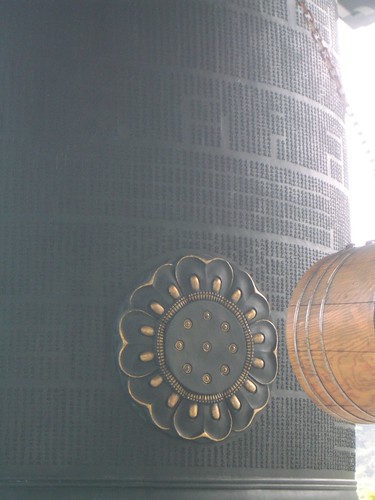
Lotus Bell III

Guayin statue

Visitors are not allowed to enter DDM’s Meditation Hall
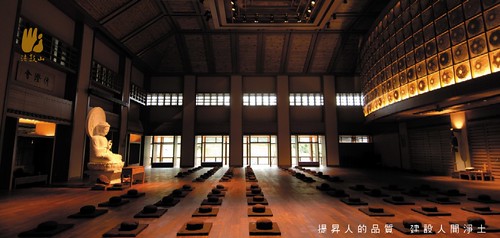
Surroundings inside DDM Meditation Hall, the center area is for sitting meditation, the outer area is for walking meditation, there is a lawn beside it as well as an alley connected to DDM’s hillside. All these areas are for retreat participants only, the Meditation Hall could hold approximately 160 people. Places for beginner’s retreats are usually full.
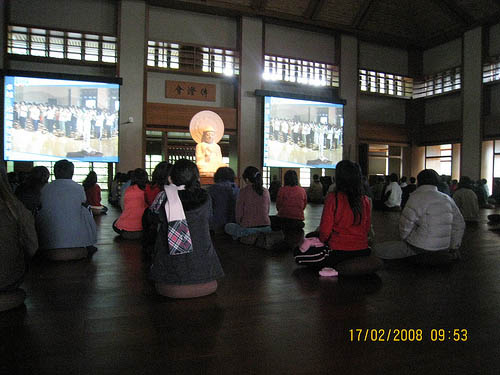
Two large projectors were installed, showing Ven. Master Sheng-yen’s dharma talks and instructions everyday.

This is a private vegetarian canteen attached next to the Meditation Hall building.
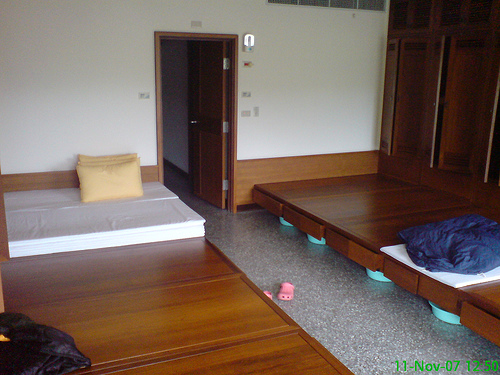
This is a typical room of the dormitory, within the Meditation Hall building, maximum 12 people in one room, with 3 individual toilets and 3 shower rooms, all of them are separated, and with warm water supplied. There’s also a public toilet at each floor of the dormitory.
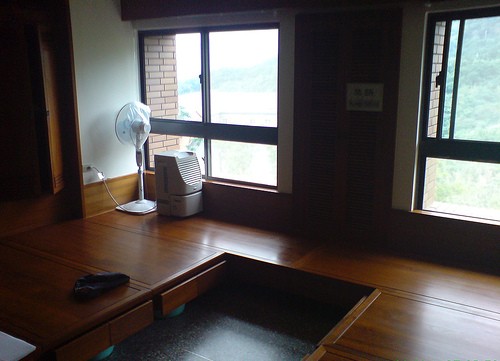
Another side of the dormitory
So this is a brief introduction of DDM and its Meditation Hall.
Registration started at 1pm on the first day of the retreat, and upon my arrival at the Meditation Hall, the Dharma workers there gave me an identity card with a reference number. A dharma worker then guided me to the dormitory and assigned me daily duties (chores) during the retreat, it is called chu po (出坡) in Chinese Buddhism and is considered as part of our cultivation. In my case, I just had to clean the room that I was staying. At about 4pm, all participants had to gather at the Meditation Hall and watch a short clip which introduced the settings and facilities of the building, rules, manners, location of the exits, etc. We then had dinner at the canteen, and at around 6pm, we had an hour evening liturgy. Not many people joined the retreat this time, with about 50 participants and only 11 of them were males. That’s probably because “Silent Illumination” was treated as an advanced technique in DDM, only those who had participated 3 times seven-day retreat could join, though it might not be limited to DDM retreats, for me, I had never joined DDM retreats but Theravada and Chinese Zen retreats, yet they still let me in, which I reckon is lenient and kind.
DDM Silent Illumination retreat schedule (as I could recall):
4:00 Get up
4:30 Exercise for half an hour in the Meditation Hall
5:00-6:00 Sitting meditation for one hour
6:00-6:45 Morning Liturgy (Great Compassion Mantra, Heart Sutra, in Chinese)
6:45 Breakfast and chores
7:45-11:00 Sitting and walking meditation (incl. watching VM Sheng-yen’s Talk on “Silent Illumination” for 30 mins)
11:00 Lunch and chores
12:30-17:00 Sitting and walking meditation
17:00 Dinner
18:00 Evening liturgy
19:00 Watching VM Sheng-yen’s Talk for 30 mins and Q &A by VM Guoyuan
20:30 Bowing Buddha
22:00 Rest and Light’s out
During the retreat, we could not take notes, listen to or read anything and had to observe noble silence, the sitting meditation each time was approximately one hour and there were about six sits per day. Sometimes we were allowed to have walking meditation (bare feet) around the hillside, listening to the flowing sounds of the streams, feeling the touch of stones or grass underneath, and observe them with the technique of Silent Illumination.
For those who had never join a Zen retreat before but interested to join one, it is noteworthy that sitting meditation of a typical retreat might sometimes be as long as 10 hours per day, so preparing your legs to sit regularly in lotus position is vital, otherwise pain from the feet could be pretty upsetting that might turn up spoiling your retreat, though some technique like Silent Illumination might help clear and penetrate the nature of pain, but for those who had not much experience might find it hard to stick with the method and felt disturbed.
The technique of Silent Illumination require practitioners to free themselves from focusing at any points (無住), no marking, no analyzing, simply aware, no contemplation of past and future, just directly observe any physical or mental phenomenon that arises with no discrimination. A special technique that it teaches is “just to know that it is sitting” (只管坐禪), with the mind clean and clear. During VM Sheng-yen’s dharma talks, he mentioned a few important gathas (i.e. Buddhist verses, 偈) for us to remember, including “let go of all phenomena, recess from all conditions (‘pacaya’ in pali; ‘pratyaya’ in sanskrit)” (放捨諸相、休息萬緣), “know but not attaching anything, illuminate but not facing any conditions.” (不觸事而知、不對緣而照), and also other lines taken from Silent Illumination (默照銘) written by Zen Patriarch Hongzhi Zhengjue. VM Sheng-yen says that Silent Illumination is different from other meditation of concentration (止) and contemplation/visualization (觀) in the sense that it is “direct observation”, not guided by breathing (anapana) or feelings (vedana), simply observe everything. To use the concept of the four foundations of mindfulness (四念處), it belongs to “inclusive states of mindfulness” (總相念); that means rather than observing body, feelings, mind, phenomenon (in pali - kaya, vedana, citta, dhamma) gradually and separately as impermanence and not-self, one observes them holistically.
Aside from elucidating the technique, VM Sheng-yen also explains the stages of enlightenment, like eight tolerances and eight wisoms (八忍八智), nine types of samadhi for bodhisattva, phases during practice, and etc. I personally rejoiced VM Sheng-yen’s talk very much, especially whist he was reciting those ancient verses written by Patriarch Hongzhi Zhengjue, the lines were written so beautifully and incredibly, the transcendental nature of silent illumination is just so profound and inexplicable that words or logics no longer applicable, it is truly the essence of Zen Buddhism.
The technique of Silent Illumination is difficult in the sense that one might find it hard to detach from any focusing points, since other conventional techniques normally have so-called kammathan (i.e. item of focus, 業處); to assist practitioners’ progress, VM Guoyuan introduced three methods to build up the bases of Silent Illumination. They are ‘relaxation’; ‘observe breath-in/out’ and ‘just know it is sitting’. To relax means ‘not using any physical strength’, relax the muscles of the body, and relax our mind. Observe breath-in/out is simply traditional anapana meditation, counting or observing the course of breath in and out around the nostril area. To know it is sitting means observing the entire body, know that I am ‘sitting’, the feelings of the body from top to bottom are not separately observe but in whole, other environment stimuli, either visual or acoustic, are also known but not discern. If one could not make this, then gradually observe feelings from top to bottom and part by part is advised.
DDM’s Silent Illumination also requires practitioner NOT to close their eyes while meditating, VM Sheng-yen explains that this helps to avoid delusive thoughts from arising, some people tend to experience delusions when they close their eyes. It also helps fighting drowsiness which sometimes misleads practitioners as experiencing a tranquil state. During practice, we had to face a brown color cloth, somewhat similar to Soto’s ‘face the wall’ technique. Personally speaking, I find opening the eyes pretty useful, it seems easier to incorporate the method with daily activities, with the eyes open, I am also training my mind to refrain from clinging visual objects, not just dealing with mental states.
Before I joined this retreat, I thought Silent Illumination was a technique that taught us to observe mental objects or delusive thoughts (like Patriarch Yongjia’s technique, 永嘉禪), but in fact it is not. In my conclusion, Silent Illumination is to maintain our mind in a clear and tranquil state (silent), but at the same time being able to observe all mind-body and environmental phenomena (illuminate). However, words are easy to say than practice, delusive thoughts and drowsiness never failed to present through out my meditation, frankly speaking, a 9-day retreat is just enough for one to have a shallow taste of the technique, in the end realization is built upon diligent practice, especially applying it in our daily encounters.
On the last day of the retreat, we had to tidy up the Meditation Hall after morning liturgy, and subsequent to having breakfast and collecting our private items, the event ended at around 8am. I was lucky and thankful that my roommate drove me back to the MRT station in Taipei. Overall, this trip was fruitful and if conditions allow, I look forward visiting DDM again in the future.
-------------------------------------
How to sign up:
DDM’s headquarter is in Jinshan, and they have branches all over the world conducting different types of meditation activities, from beginner to advanced level, 1-day to 49-day retreats. Interested parties can check out http://www.dharmadrum.org/activities/activities.aspx for details. For those who could read Chinese, you may visit http://chan.ddm.org.tw/.
-------------------------------------
Namo Amitabha!

沒有留言:
張貼留言